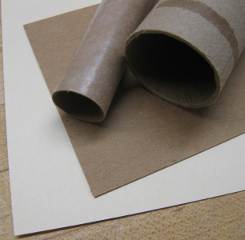Paper in Ship Model Building
Paper in Ship Model Building has a long track record. Find out how paper, card stock, board, tissue, and Silkspan can enhance your model boats and ships.
Making a paper ship model in the age of instant glue, epoxy and carbon fiber may seem remote to most, but it is still a highly viable material. Here is a list of paper types and how/where it can be put to good use in model ship building.
Paper, Card stock, Fiber Board, and Bristol board
Paper, being a two-dimensional sheet material, may seem foreign to most people to work into a detailed scale model, however there are several benefits. Some of which are:
- Inexpensive
- Comes in large formats
- Easy to cut with hand tools
Paper Ship Models
Building scale models entirely from paper or card stock has a large following, primarily in Europe, Russia and Japan. Paper model kits don't typically come in a box, but rather in a booklet or a file to be downloaded directly from the internet, and printed on your own printer.
I have not built a lot of these kits, but they can be very intimidating to a beginner. For anybody interested, I suggest starting with something easy and develop your skills from there.
There are not a lot of books on the subject either, unfortunately, but many of the beginner models come with basic instructions that make a good foundation for lasting habits.
All kinds of ships are represented in these kits. From ocean liners and battleships to sailing ships like frigates and viking ships.
Paper in RC model boats
Fiber board and card stock can be used in RC boats. I've also used paper shipping tubes when round sections were needed. The PT-109 deck houses is a good example.

|
The challenge is in sealing it and achieving a smooth finish. The way I accomplish this is, after attaching a component, I seal the fiberboard by soaking it in CA glue. The board essentially turns into fiber-reinforced acrylic.
So far it shows promise of being entirely sealed throughout against moisture, extremely strong, sands easily and finishes well. I like it over materials like styrene sheet, because it seems stronger and probably more stable over time.
So far I've used the Chip Board and even cut up Manilla file folders to represent the superstructure on RC models. I'm curious to see how it will do as a hull-skin material.
Tissue Paper or Rice Paper
Tissue paper, also known as rice paper, has been used for centuries to seal light and porous materials like balsa wood. I have a page explaining the Tissue and Dope process.
Silkspan
Silkspan is a fiber material, not unlike tissue paper but definitely thicker and it feels more like fabric to the touch. Rumors have it that it is very similar to the paper in tea bags.
I used it once many years ago, but at the time didn't know what it was. I have recently reconnected with the material and love it. By far my favorite material to use in place of regular tissue paper in the tissue & dope process. The main benefit is that it a single layer of silkspan and multiple coats of dope builds a durable shell that would take 3-4 layers of tissue paper.
Another good use of Silkspan is when representing furled sails on age-of-sail wooden or plastic models.
So, as you can see, there are a multitude of opportunity to use paper in a ship model.





